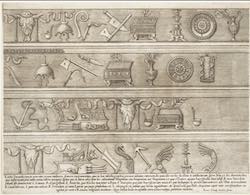Topic: 2. Sacrifice and religion: Comparisons, Antiquarians, Anthropology (16th-18th Century)
Religious sacrifices across various cultures and contexts sparked widespread interest in Early Modern Europe. As Christianity expanded into regions inhabited by "infidels" and "pagans", Europeans encountered a diverse array of sacrificial customs, ranging from the Sati rituals in India to the Aztec sacrifices in the Americas. This cross-cultural exposure captivated a wide audience, including theologians, philosophers, political thinkers, antiquarians, orientalists, missionaries, poets, artists, and even the general public. These encounters broadened the European understanding of sacrifice and led to a critical reassessment of classical and biblical sacrificial rites. This section includes:
- Sources: A selection of early modern printed materials, which include descriptions of the Americas, Asia, and Africa, alongside antiquarian and philological studies on religious sacrifice in classical antiquity and beyond. It also presents early modern works of ethnological observations and the first attempts to compare different sacrificial practices in various traditions and contexts, laying the groundwork for disciplines like the history of religions and anthropology.
- Iconographic Representations: A rich collection of images from the 16th to 18th centuries, illustrating a range of sacrificial rituals and practices as seen in different cultural and geographical contexts.
- Related Bibliography: An extensive bibliography spanning scholarly works from the 19th to 21st centuries, providing contemporary analyses and interpretations of these early studies and observations.
Mesoamerican Mosaics from Early European Collections: Style, Provenance and Provenience
in: Estudios De Cultura Náhuatl , v. 59 (2020), issue : pp.7-65.
Rediscovery of a Mesoamerican greenstone sculpture from the collection of Ulisse Aldrovandi
in: Journal of the History of Collections, v. 34 (2022), issue 1: pp.1-22.
The Descrittione dell’India occidentale, a Sixteenth-Century Source on the Italian Reception of Mesoamerican Material Culture
in: Ethnohistory, v. 64 (2017), issue 4: pp.497-527.
Missionary Gift Records of Mexican Objects in Early Modern Italy
in: The New World in Early Modern Italy, 1492–1750, pp. 86-103
: , 2017.
Three Bolognese Franciscan Missionaries in the New World in the Early Sixteenth Century
in: The New World in Early Modern Italy, 1492–1750, pp. 63-85
: , 2017.
Tales of Sex and Violence: Folklore, Sacrifice, and Danger in the Jaiminīya Brāhmaṇa
Chicago: University if Chicago Press, 1985.
L’organizzazione pubblica del sacrificio dell’’îd al kabîr (Bologna 1998)
in: La Ricerca Folklorica, v. 44 (2001), issue : pp.85-94.
Some remarks on the ritual significance of the bull in pre-Islamic South Arabia
in: Arabian and Islamic studies: articles presented to R.B. Serjeant, pp. 196-213
Harlow: Longman, 1983.
The Forbidden Animals in Leviticus
in: Journal for the Study of the Old Testament, v. (1993), issue 59: pp.3-23.
1. Sacrifice and Bible (16th-18th Century) 2. Sacrifice and religion: Comparisons, Antiquarians, Anthropology (16th-18th Century)
Atonement in Leviticus
in: Jewish Studies Quarterly , v. 1 (1993-1994), issue 2: pp.109-130.
Of Camels, Crocodiles and Human Sacrifice. The North Carolina MS of Solinus' De situ orbis terrarum and Readings of Classical Geography in the Renaissance
in: International Journal of the Classical Tradition, v. 18 (2011), issue 2: pp.167-200.
Technique et sacrifice dans la metallurgie africaine
Paris: Universite Paris, Departement d'economie appliquée, 1994.
The Sacrificial Rtual in the Śatapatha Brāhmaṇa
Delhi: Motilal Banarsidass, 1981.
Frieze of Sacrificial Instruments (1580 - 1585)
from: Lafréry, Antoine. Speculum Romanae Magnificentiae [...], Roma, n. p., 1553, A 128
University of Chicago Library, Chicago
The Legend of Miaoshan
London: Ithaca Press, 1978.
in: Divine Consumption : Sacrifice, Alliance building, and making Ancestors in West Africa, pp.
Los Angeles: The Cotsen Institute of Archaeology Press, 2022.
L’Aśvamedha: Description du sacrifice solennel du cheval dans le culte védique d'aprés les textes du Yajurveda blanc (Vājasaneyisaṃhitā, Śatapathabrāhmaṇa, Kātyāyanaśrautasûtra)
Louvain - Paris: Paul Geuthner - Istas Imprimeur, 1927.


